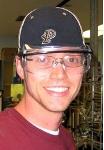Org. Synth. 2010, 87, 263
DOI: 10.15227/orgsyn.087.0263
Pd(0)-CATALYZED ASYMMETRIC ALLYLIC AND HOMOALLYLIC DIAMINATION OF 4-PHENYL-1-BUTENE WITH DI-TERT-BUTYLDIAZIRIDINONE
Submitted by Baoguo Zhao, Haifeng Du, Renzhong Fu, and Yian Shi
*1.
Checked by Eric E. Buck and Peter Wipf
2.
1. Procedure
A. (S)-1-(8,9,10,11,12,13,14,15-Octahydro-3,5-dioxa-4-phosphacyclohepta[2,1-a;3,4-a']dinaphthalen-4-yl)-2,2,6,6-tetramethylpiperidine [(S)-1]. A 250-mL, two-necked, round-bottomed flask equipped with a Teflon-coated magnetic stir bar (length: 3.5 cm), internal thermometer, nitrogen inlet, and rubber septum is charged with 2,2,6,6-tetramethylpiperidine (5.13 mL, 29.5 mmol, 1.24 equiv) and anhydrous THF (47.2 mL) (Notes 1, 2, and 3). The solution is cooled to 5 °C in an ice bath, treated with n-BuLi (19.5 mL, 29.8 mmol, 1.53 M in hexanes, 1.25 equiv) by syringe over 5 min, and stirred at 0 °C for 30 min (Notes 4 and 5). To this solution is added phosphorus trichloride (PCl3) (7.75 mL, 88.8 mmol, 3.73 equiv) at such a rate as to keep the internal temperature below 10 °C (ca. 30 min) (Note 6). After complete addition of PCl3, the ice bath is removed, and the brown reaction mixture is stirred for 1 h and concentrated by rotary evaporation (25 °C, 55 mmHg) (Notes 7 and 8). The resulting residue is dissolved in THF (71.0 mL) and cooled to 5 °C in an ice bath. A solution of (S)-H8-BINOL (7.08 g, 23.8 mmol, 1.00 equiv) and Et3N (10.1 mL, 71.4 mmol, 3.00 equiv) in THF (17.8 mL) is added by syringe pump over 15 min (Notes 9 and 10). The ice bath is removed. The reaction mixture is stirred for 20 h and concentrated by rotary evaporation (25 °C, 18 mmHg) (Note 11). The resulting residue is dissolved in toluene (60
mL) and the mixture is vacuum filtered (water aspirator, 45 mmHg) through a Büchner funnel (150 mL, 40-60 astm) (Note 12). The solid is washed with toluene (3 × 20 mL), the combined filtrates are concentrated by rotary evaporation (40 °C, 18 mmHg), and the residue is diluted with a toluene/dichloromethane/Et3N solution (25 mL, 2:1:1.5). The solution is loaded onto a wet-packed neutral Al2O3 column (250 g Al2O3, diameter: 4.5 cm, height: 18 cm, pretreated with toluene/Et3N, 20:1). The product is eluted with toluene/Et3N (20:1) to give(S)-1 as a pale yellow solid (9.94 g) (Note 13). The solid is recrystallized from ethyl acetate (90
mL) and dried at 85 °C under vacuum for 4 h (87.0 mmHg) to give (S)-1 as colorless crystals (7.79 g, 70%) (Notes 14, 15, and 16).
B. (4S,5S)-1,3-Di-tert-butyl-4-phenyl-5-vinylimidazolidin-2-one (3). A 100-mL, three-necked, round-bottomed flask equipped with a Teflon-coated magnetic stir bar (length: 2.5 cm), argon inlet, and rubber septum is charged with Pd2(dba)3 (1.27 g, 1.37 mmol, 0.05 equiv) and ligand (S)-1 (2.81 g, 6.03 mmol, 0.22 equiv) (Note 17). The flask is evacuated and back-filled with argon three times; benzene (2.94 mL) is added, and the mixture is placed in a preheated oil bath at 65 °C and stirred for 40 min (Note 18). To the heated mixture is added 4-phenyl-1-butene (4.20 mL, 27.4 mmol, 1.00 equiv) followed by the addition of di-tert-butyldiaziridinone (2) (9.81 g, 57.6 mmol, 2.1 equiv) by syringe pump at a rate of 0.7 mL/h (17 h) (Notes 19 and 20). After complete addition, the reaction mixture is stirred for an additional 3 h, cooled to room temperature, and diluted with hexanes (30
mL) (Note 21). The mixture is vacuum filtered (water aspirator, 45 mmHg) through a Büchner funnel (150 mL, 40-60 astm), and the solid is washed with hexanes (5 × 20 mL). The combined filtrate is concentrated and the residue is diluted with hexanes/diethyl ether (6:1, 5 mL) (Note 22). The solution is loaded onto a wet-packed SiO2 column (206 g SiO2, diameter: 5.5 cm, height: 22.5 cm, pretreated with hexanes/diethyl ether, 6:1) (Note 23). The product is eluted with hexanes/diethyl ether (6:1) to give diamination product 3 along with a small amount of dibenzylideneacetone (dba). The resulting residue is diluted with hexanes/diethyl ether (6:1, 5 mL). The solution is loaded onto a wet-packed SiO2 column (206 g SiO2, diameter: 5.5 cm, height: 22.5 cm, pretreated with hexanes/diethyl ether, 6:1). The product is eluted with hexanes/diethyl ether (6:1) to give 6.02 g (73%) of diamination product 3 as a pale yellow oil (90% ee) (Notes 24, 25 and 26).
2. Notes
1.
All glassware was flame dried under a nitrogen atmosphere.
2.
The checkers purchased 2,2,6,6-tetramethylpiperidine (98+%) from Alfa Aesar and used it as received.
3.
The checkers purchased tetrahydrofuran (ACS grade) from Fisher Chemicals and dried it by distillation over sodium/benzophenone ketyl under an argon atmosphere.
4.
The checkers purchased
n-butyllithium (1.6 M solution in hexanes) from Sigma-Aldrich and used it as received.
5.
n-Butyllithium was titrated before each use using the following protocol: A 25-mL, one-necked, round-bottomed flask equipped with a rubber septum and a nitrogen inlet was charged with (
L)-menthol (
ca 200 mg) and dipyridine (
ca 5 mg). The flask was cooled to 5 °C in an ice bath and charged with
THF (10) followed by a known volume of
n-BuLi (1.6 M solution in hexanes).
6.
The checkers purchased phosphorus trichloride (99%) from Sigma-Aldrich and used it as received.
7.
Due to the toxicity of phosphorus trichloride, the mixture was concentrated in a fume hood.
8.
The remaining trace amount of PCl
3was removed under vacuum (25 °C, 0.05 mmHg) for 4 h.
9.
The checkers purchased (
S)-H
8-BINOL (99%) from TCI America and used it as received.
10.
The checkers purchased triethylamine (99%) from Fisher Chemicals, dried by distillation over CaH
2, and stored it over potassium hydroxide.
11.
The reaction can be monitored by TLC on precoated Al
2O
3 150 F
254 plates (purchased from Merck, Darmstadt, Germany) (toluene/Et
3N, 20:1 (
Rf = 0.9)). The TLC plate was pretreated with toluene/Et
3N, 20:1.
12.
The checkers purchased toluene (ACS grade) from Fisher Chemicals and dried it by passing through activated alumina.
13.
Aluminum oxide, activated, neutral, Brockmann I, standard grade, ~150 mesh, 58 Å, Sigma-Aldrich. The fractions containing the product (
Rf = 0.9, toluene/Et
3N, 20:1) were combined and concentrated.
14.
The checkers purchased
ethyl acetate (ACS grade) from Mallinckrodt Chemicals and distilled it under argon.
15.
Working at 50% scale, the checkers obtained 4.01 g (72.4%).
16.
The product has the following physicochemical properties: Colorless crystal, Mp 199-201 °C; [α]
20D +153.0 (
c 1.0, CHCl
3);
1H NMR
pdf (300 MHz, benzene-
d6) δ: 1.16-1.60 (m, 26 H), 2.18-2.38 (m, 2 H), 2.48-2.74 (m, 6 H), 6.92 (d, 1 H,
J = 8.4 Hz,), 6.98 (d, 1 H,
J = 8.4 Hz), 7.10 (d, 1 H,
J = 8.1 Hz), 7.12 (d, 1 H,
J = 8.1 Hz);
13C NMR
pdf (150 MHz, CDCl
3) δ: 17.4, 22.8, 23.0 (2), 27.9, 28.2, 29.2, 29.5, 32.2 (2), 43.0, 56.2 (2), 119.2 (2), 119.5, 128.1 (2), 128.8, 129.7, 130.0 (2), 132.2, 134.1, 137.9, 138.3 (2), 149.7, 149.8, 149.9;
31P NMR
pdf (121 MHz, benzene-
d6) δ: 164.5; IR (ATR) 1579, 1467, 1232 cm
-1; HRMS (EI+)
m/z calcd. for C
29H
40NO
2P 465.2797; found 465.2787; Anal. calcd. for C
29H
38NO
2P: C, 75.13; H, 8.26; N, 3.02; found: C, 74.80; H, 8.26; N, 2.97.
17.
The checkers purchased tris(dibenzylideneacetone)dipalladium(0) from Strem and used it as received.
18.
The checkers purchased benzene from EMD Chemicals and dried it by distillation over sodium/benzophenone ketyl under a nitrogen atmosphere.
19.
The checkers purchased 4-phenyl-1-butene (98%) from TCI America and used it as received.
20.
Di-
tert-butyldiaziridinone (
2) was prepared according to a recent
Organic Syntheses procedure: Du, H.; Zhao, B.; and Shi, Y.
Org. Synth.
2009,
86, 315-323.
21.
The checkers purchased hexanes (ACS grade) from EMD Chemicals and used it as received.
22.
The checkers purchased diethyl ether (ACS grade) from EMD Chemicals and used it as received.
23.
Silica gel 40-63 μm (60 Å) (Silicycle, Quebec City, Canada) was used. The fractions containing the product (
Rf = 0.4, hexanes/Et
2O, 6:1) were combined and concentrated.
24.
Working at 50% scale, the checkers obtained 2.95 g (71.7 %).
25.
The product has the following physicochemical properties: Pale yellow oil; [α]
20D -30.5 (
c 1.0, CHCl
3) (90% ee);
1H NMR
pdf (300 MHz, CDCl
3) δ: 1.28 (s, 9 H), 1.33 (s, 9 H), 3.65 (d, 1 H,
J = 8.1 Hz), 4.16 (d, 1 H,
J = 1.2 Hz), 5.16 (d, 1 H,
J = 9.6 Hz), 5.20 (d, 1 H,
J = 15.9 Hz), 6.03 (ddd, 1 H,
J = 8.1, 9.9, 17.1 Hz), 7.37-7.28 (m, 5 H);
13C NMR
pdf (75 MHz, CDCl
3) δ: 28.9, 29.0, 53.4, 53.7, 63.3, 64.9, 115.8, 125.9, 127.9, 128.9, 140.9, 144.1, 159.2; IR (ATR) 1683 cm
-1; HRMS (ES+)
m/z calcd. for C
19H
28N
2ONa ([M+Na]
+) 323.2099; found 323.2079; Anal. calcd. for C
19H
28N
2O: C, 75.96; H, 9.39; N, 9.32; found: C, 75.84; H, 9.45; N, 9.38.
26.
The enantiomeric excess is determined by chiral HPLC (Chiralpak AD column, flow rate: 0.7 mL/min, eluent: hexanes/
iPrOH 4:1, t
+ = 8.0 min, t
- = 11.2 min) after removal of the two
tert-butyl groups. The deprotection is carried out with the following procedure:
8a A 5-mL screw-capped vial is charged with diamination product
3(30.0 mg, 0.0999 mmol) and
CF3CO2H (0.50 mL) (Note 27). The solution is placed into a preheated oil bath at 75-80 °C for 2 h, cooled to room temperature, and concentrated by rotary evaporation (25 °C, 18 mmHg). The residue is loaded onto a wet-packed SiO
2 column (diameter: 2.0 cm, height: 14.0 cm, pretreated with hexanes/diethyl ether, 4:1). The product is eluted with hexanes/diethyl ether, 4:1) to give 15.1 mg (93%) of the deprotected diamination product as a white powder (90% ee; Mp 204 °C (dec.)) (Notes
21,
22 and
23). The deprotected product is analyzed by chiral HPLC.
27.
The checkers purchased trifluoroacetic acid (99%) from Alfa Aesar and used it as received.
Safety and Waste Disposal Information All hazardous materials should be handled and disposed of in accordance with "Prudent Practices in the Laboratory"; National Academy Press; Washington, DC, 1995.
3. Discussion
Metal-mediated or catalyzed diamination of olefins is an attractive strategy for the construction of vicinal diamines and their derivatives.
3,4,5 Recently, we found that di-
tert-butyldiaziridinone (
2)
6,7 is an efficient diamination reagent for olefins with Pd(0) and Cu(I) catalysts.
8,9 When Pd(0) is used as the catalyst, a variety of dienes
4 can be regioselectively diaminated on the internal double bond to give compounds
5 in high yields under mild conditions (Scheme 1).
8a,b,d,e Further studies show that simple terminal olefins
6 can be diaminated at the allylic and homoallylic carbons to give similar diamination products
7(Scheme 1).
8c,fScheme 1
A possible mechanism for this C-H diamination is shown in Scheme 2.
8c The Pd(0) complex initially inserts into the N-N bond of di-
tert-butyldiaziridinone (
2) to form four-membered Pd(II) species
8, which coordinates with olefin
6 and forms π-allyl Pd(II) complex
10upon allylic H extraction. ß-H elimination of
10 gives diene
11 and regenerates the Pd(0) catalyst. The formed diene (
11) coordinates with Pd(II) species
8 and generates π-allyl Pd(II) complex
14upon aminopalladation to the internal double bond. Pd(II) species
14 undergoes reductive elimination to give diamination product
7and regenerates the Pd(0) catalyst.
Scheme 2
When the chiral phosphorus ligand (
R)-
1 is used, asymmetric C-H diamination can be achieved under mild conditions as shown in Scheme 3.
8f,g A variety of terminal olefins are efficiently C-H diaminated in good yields and high enantioselectivities (Table 1). When 1,9-decadiene and 1,7-octadiene are used, four C-H bonds can be replaced with four C-N bonds in an enantioselective fashion.
Scheme 3
Table 1. Asymmetric Allylic and Homoallylic C-H Diamination of Terminal Olefins
Appendix
Chemical Abstracts Nomenclature (Collective Index Number);
(Registry Number)
2,2,6,6-Tetramethylpiperidine; (768-66-1)
Phosphorus trichloride (7719-12-2)
(S)-H8-BINOL: (1S)-5,5',6,6',7,7',8,8'-octahydro-[1,1'-Binaphthalene]-2,2'-diol; (65355-00-2)
(S)-1-(8,9,10,11,12,13,14,15-Octahydro-3,5-dioxa-4-phosphacyclohepta[2,1-a;3,4-a']dinaphthalen-4-yl)-2,2,6,6-tetramethylpiperidine
Pd2(dba)3: Tris(dibenzylideneacetone)dipalladium; (51364-51-3)
Di-tert-butyldiaziridinone: 3-Diaziridinone, 1,2-bis(1,1-dimethylethyl)-; (19656-74-7)
(4S,5S)-1,3-Di-tert-butyl-4-phenyl-5-vinylimidazolidin-2-one: (4R, 5R)-1,3-bis(1,1-dimethylethyl)-4-ethenyl-5-phenyl-2-imidazolidinone; (9279 02-91-8)
 |
Yian Shi was born in Jiangsu, China in 1963. He obtained his B.Sc. degree from Nanjing University in 1983, M.Sc. degree from University of Toronto with Professor Ian W.J. Still in 1987, and Ph.D. degree from Stanford University with Professor Barry M. Trost in 1992. After a postdoctoral study at Harvard Medical School with Professor Christopher Walsh, he joined Colorado State University as assistant professor in 1995 and was promoted to associate professor in 2000 and professor in 2003. His current research interests include the development of new synthetic methods, asymmetric catalysis, and synthesis of natural products. |
 |
Baoguo Zhao was born in Hubei, China in 1973. He received his B.Sc. degree from Wuhan University in 1996 and M.Sc. degree from Nanjing University in 2002 under the supervision of Professor Jianhua Xu. After completing his Ph.D. degree under the supervision of Professor Kuiling Ding at Shanghai Institute of Organic Chemistry, Chinese Academy of Science in 2006, he joined the Department of Chemistry at Colorado State University as a postdoctoral fellow with Professor Yian Shi. His current research interests include the development of novel synthetic methodology and asymmetric synthesis. |
 |
Haifeng Du was born in Jilin, China in 1974. He received his B.Sc. degree in 1998 and M.Sc. degree in 2001 from Nankai University. He then moved to Shanghai Institute of Organic Chemistry, Chinese Academy of Sciences, and obtained his Ph.D. degree in 2004 under the supervision of Professor Kuiling Ding. In the fall of 2004, he joined the Department of Chemistry at Colorado State University as a postdoctoral fellow with Professor Yian Shi. His research interests include the development of novel synthetic methodology and asymmetric synthesis. |
 |
Renzhong Fu was born in Shanxi, China, in 1981. He obtained his B.Sc. degree in Chemistry from Jilin University in 2003. He received his Ph.D. degree in Organic Chemistry in 2008 from Jilin University under the direction of Professor Xu Bai. His doctoral research studies focused on design and synthesis of novel pyrimidine-fused heterocyclic scaffolds. In September 2008, he joined the laboratory of Professor Yian Shi at Colorado State University as a postdoctoral fellow. His current research interest is the development of novel asymmetric catalytic methodology. |
 |
Eric Buck was born in 1985 in Fairmont, West Virginia. He graduated from the University of Minnesota with his B.Sc. in 2006. During his freshman year he entered the laboratory of Professor Thomas R. Hoye where he pursued the synthesis of petromyzonamine disulfate analogs with a focus on 5-β petromyzonamine disufate. While attending the U of M he was supported by the David A. and Merece H. Johnson Scholarship. In 2007 he moved to Pittsburgh, Pennsylvania, where he is currently a graduate student under the direction of Professor Peter Wipf. His current research interests include asymmetric synthesis and the synthesis of natural products. |
Copyright © 1921-, Organic Syntheses, Inc. All Rights Reserved